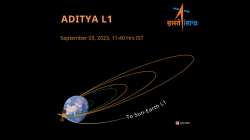Aditya-L1: Satellite is healthy, first Earth-bound manoeuvre performed successfully, tweets ISRO
The PSLV C57 rocket carrying the Aditya-L1 orbiter, lifted off successfully from the Satish Dhawan Space Centre in Sriharikota, Andhra Pradesh on September 2.

Aditya-L1 Mission: A day after the Indian Space Research Organisation (ISRO) successfully launched India’s first solar mission, Aditya-L1, the first Earth-bound manoeuvre was performed on Sunday. The space agency further said that Aditya-L1, the country's first solar mission, is healthy and operating nominally.
“The satellite is healthy and operating nominally. The first Earth-bound maneuvre (EBN#1) is performed successfully from ISTRAC, Bengaluru. The new orbit attained is 245km x 22459 km. The next maneuvre (EBN#2) is scheduled for September 5, 2023, around 03:00 Hrs. IST”, ISRO posted on X.
Aditya L1 lifted off successfully
ISRO on Saturday launched the country's ambitious Solar mission, Aditya L1. The 44.4 meter tall Polar Satellite Launch Vehicle (PSLV) soared majestically at the prefixed time of 11.50 am from this spaceport, located on the Eastern coast about 135 km from Chennai.
According to ISRO, Aditya-L1 is the first space-based observatory to study the Sun. The spacecraft, after travelling about 1.5 million km from the Earth over 125 days, is expected to be placed in a Halo orbit around the Lagrangian point L1 which is considered closest to the Sun. It will be PSLV's "longest flight" for about 63 minutes.
The spacecraft was launched towards the Lagrange L1 point using on-board propulsion so that it exits the earth's gravitational Sphere of Influence and cruises towards the L1. Later, it would be injected into a large Halo Orbit around L1 point near the Sun. The total time from launch to reaching the L1 point would be about four months for the Aditya-L1 Mission, ISRO said.
The Aditya-L1 mission carries seven scientific payloads to carry out the study. Major objectives of India’s solar mission include the study of the physics of solar corona and its heating mechanism, the solar wind acceleration, coupling and dynamics of the solar atmosphere, solar wind distribution and temperature anisotropy, and origin of Coronal Mass Ejections (CME) and flares and near-earth space weather.
Also Read: Aditya-L1 launch: How European Space Agency is assisting ISRO's maiden solar mission?